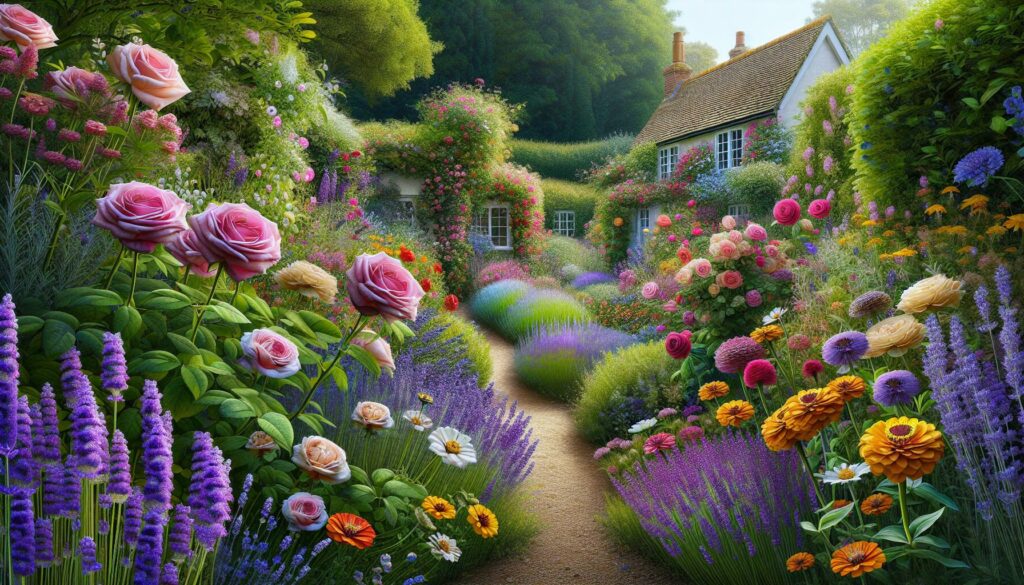As a lifelong gardening enthusiast, I’ve always been captivated by the timeless beauty of flowers. There’s something magical about how these delicate blooms can transform any space into a vibrant paradise while lifting our spirits with their stunning colors and enchanting fragrances.
I’ve spent countless hours exploring gardens worldwide and documenting nature’s most spectacular floral displays. Whether it’s the elegant simplicity of a single rose or the dramatic impact of a mass planting I’ve discovered that flowers possess an unmatched ability to create emotional connections and bring joy to our daily lives. From crafting stunning arrangements to designing breathtaking gardens I’ll share my expertise to help you understand and appreciate these natural wonders that surround us.
Key Takeaways
- Beautiful flowers come in both annual varieties (like zinnias and marigolds) that bloom for one season and perennial types (such as peonies and daylilies) that return yearly
- Successful flower gardens require proper placement based on sunlight needs (6-8 hours for most flowers) and soil conditions (pH 6.0-7.0 is ideal for most varieties)
- Regular maintenance including deep morning watering, seasonal fertilizing (every 4-6 weeks for annuals), and integrated pest management is essential for healthy blooms
- Professional-looking flower arrangements follow design principles like color harmony (monochromatic, complementary, or analogous schemes), proper height ratios, and balanced proportions
- Different flowers thrive in specific seasons – spring bulbs bloom early, heat-loving varieties peak in summer, fall brings chrysanthemums and asters, while some species flower through winter
Beautiful:v5ob5_oqpve= Flower
Throughout my extensive gardening experience, I’ve cultivated numerous flower varieties that create stunning visual displays in gardens. Here’s my expert guide to the most captivating garden flowers, categorized by their lifecycle patterns.
Annual vs Perennial Blooms
Annual flowers complete their lifecycle in one growing season, while perennials return year after year. I’ve found that annuals like zinnias, marigolds, impatiens, petunias provide immediate, vibrant color impacts from spring through fall. Perennials such as peonies, daylilies, black-eyed susans establish strong root systems, delivering reliable blooms each season with minimal maintenance.
| Flower Type | Lifecycle | Bloom Duration | Maintenance Level |
|---|---|---|---|
| Annuals | 1 season | 3-8 months | High |
| Perennials | Multiple years | 2-6 weeks per season | Low |
Popular Flower Varieties
My garden features these sought-after flowering plants that consistently deliver stunning results:
- Roses: Heritage varieties include ‘Peace’, ‘Double Delight’, ‘Mr. Lincoln’
- Hydrangeas: Mophead, lacecap, oakleaf cultivars in pink, blue, white
- Tulips: Darwin hybrids, parrot tulips, triumph varieties in spring
- Lilies: Asiatic, oriental, tiger types with dramatic blooms
- Dahlias: Decorative, cactus, pompom forms in diverse colors
- Chrysanthemums: Spider, cushion, anemone styles for fall color
- Lavender: English, French, Spanish species with fragrant purple spikes
- Bloom times (early spring through late fall)
- Height ranges (4 inches to 6 feet)
- Color patterns (solid, bicolor, variegated)
- Growth habits (climbing, spreading, upright)
- Sun requirements (full sun to partial shade)
Choosing the Right Location for Your Flowers
Selecting an optimal location determines the success of your flower garden. I’ve discovered through years of gardening that proper placement significantly impacts flower growth, bloom quality and overall plant health.
Sunlight Requirements
Most flowering plants thrive in locations receiving 6-8 hours of direct sunlight daily. From my experience cultivating various flower species, I categorize sunlight needs into these groups:
- Full Sun (6+ hours): Roses, zinnias, marigolds, petunias
- Partial Sun (4-6 hours): Hydrangeas, columbines, foxgloves
- Partial Shade (2-4 hours): Impatiens, begonias, hostas
- Full Shade (< 2 hours): Fuchsias, bleeding hearts
- pH Levels: Most flowers prefer slightly acidic soil (6.0-7.0)
- Drainage: Well-draining soil prevents root rot
- Composition:
- 40% native soil
- 40% organic matter
- 20% sand or perlite
| Soil Type | Best Flowers | pH Range |
|---|---|---|
| Sandy | Lavender, Yarrow | 5.5-6.5 |
| Clay | Daylilies, Black-eyed Susans | 6.0-7.0 |
| Loamy | Roses, Peonies | 6.0-7.5 |
Essential Growing Tips and Care
Optimal flower growth requires specific care routines for watering, fertilizing and pest management. Based on my extensive gardening experience, I’ve developed effective strategies for maintaining healthy blooms throughout the growing season.
Watering and Fertilizing
I water flowers deeply at the base during early morning hours to minimize evaporation and prevent leaf diseases. For container plants, I check soil moisture by inserting my finger 1-2 inches deep – if it feels dry, it’s time to water. Most established flowers need 1-2 inches of water weekly through rainfall or irrigation.
Fertilizer application schedule:
| Flower Type | Fertilizer Timing | NPK Ratio |
|---|---|---|
| Annuals | Every 4-6 weeks | 5-10-5 |
| Perennials | Early spring and mid-summer | 10-10-10 |
| Bulbs | When shoots emerge and after blooming | 3-5-3 |
Pest Control
I implement integrated pest management techniques to protect flowers from common garden pests:
- Monitor plants twice weekly for signs of damage or infestations
- Remove affected leaves pruning tools sanitized with 70% alcohol
- Introduce beneficial insects like ladybugs parasitic wasps to control aphids caterpillars
- Apply insecticidal soap sprays for soft-bodied pests when pest populations exceed 10 per leaf
- Place physical barriers such as copper tape around containers to deter slugs snails
- Maintain 2-3 inches of mulch around plants to prevent soil-dwelling pests
- Space plants 12-18 inches apart for proper air circulation
- Water at soil level instead of overhead spraying
- Remove plant debris regularly to prevent fungal growth
- Apply organic fungicides at first signs of powdery mildew or black spot
Creating Stunning Flower Arrangements
I create professional floral arrangements by combining specific design techniques with carefully selected blooms. My experience with various flower types enables me to craft arrangements that serve as striking focal points in any space.
Color Combinations
Color harmony forms the foundation of eye-catching floral arrangements through these proven combinations:
- Monochromatic: Single color variations create elegant sophistication (light pink roses with deep magenta peonies)
- Complementary: Opposite colors on the color wheel produce dramatic contrast (purple irises with yellow daffodils)
- Analogous: Adjacent colors offer subtle transitions (orange marigolds with red zinnias)
- Triadic: Three equidistant colors create balanced vibrancy (blue delphiniums with red roses yellow tulips)
| Color Scheme | Primary Colors | Example Flowers |
|---|---|---|
| Monochromatic | Pink | Roses Peonies Carnations |
| Complementary | Purple Yellow | Irises Daffodils |
| Analogous | Orange Red | Marigolds Zinnias |
| Triadic | Blue Red Yellow | Delphiniums Roses Tulips |
- Height Variation: Tallest flowers at 1.5-2x vase height with graduated levels
- Focal Point: Large blooms positioned at eye level (hydrangeas peonies sunflowers)
- Balance: Equal visual weight distribution through flower size color placement
- Texture: Mix of smooth round delicate spiky flowers (roses Queen Anne’s lace ornamental grasses)
- Proportion: Container size matches arrangement volume at 1:1.5 ratio
- Space: 30% negative space between blooms for visual breathing room
- Depth: Layered placement creates three-dimensional interest
| Design Element | Measurement | Example Application |
|---|---|---|
| Height Ratio | 1.5-2x vase | 12″” vase = 18-24″” arrangement |
| Visual Balance | 50/50 split | Equal mass both sides |
| Negative Space | 30% | Air gaps between flower groupings |
| Container Ratio | 1:1.5 | 6″” vase = 9″” arrangement width |
Best Seasons for Growing Beautiful Flowers
Spring (March to May)
- I plant frost-resistant bulbs like tulips daffodils iris in early spring
- I sow hardy annuals including pansies sweet peas snapdragons for immediate color
- I start summer-blooming perennials such as coneflowers black-eyed susans during late spring
- I witness peak bloom periods for azaleas rhododendrons cherry blossoms
Summer (June to August)
- I cultivate heat-loving flowers including zinnias marigolds petunias sunflowers
- I maintain flowering perennials like daylilies phlox black-eyed susans
- I grow climbing varieties such as morning glories clematis moonflowers
- I tend to drought-resistant blooms including lantana verbena portulaca
Fall (September to November)
- I plant chrysanthemums asters goldenrod for autumn displays
- I establish spring-blooming bulbs including tulips daffodils hyacinths
- I sow hardy annuals like pansies violas for early spring color
- I divide propagate perennials such as hostas daylilies irises
- I force indoor bulbs including paperwhites amaryllis for winter blooms
- I grow cold-hardy flowers such as hellebores winter jasmine camellias
- I start seeds indoors for spring planting including petunias salvias snapdragons
- I maintain winter-blooming shrubs like witch hazel winter heath mahonia
| Season | Average Temperature Range (°F) | Typical Rainfall (inches) | Primary Blooming Flowers |
|---|---|---|---|
| Spring | 45-65 | 3-4 | Tulips, Daffodils, Iris |
| Summer | 70-85 | 2-3 | Zinnias, Marigolds, Petunias |
| Fall | 45-65 | 3-4 | Chrysanthemums, Asters, Goldenrod |
| Winter | 25-40 | 2-3 | Hellebores, Winter Jasmine, Camellias |
Creating a beautiful flower garden is a rewarding journey that brings joy and tranquility to any space. Throughout my years of gardening I’ve learned that success comes from understanding each flower’s unique needs and cycles. Whether you’re drawn to vibrant annuals bold perennials or a mix of both there’s a perfect combination waiting for your garden.
I hope my insights on flower selection planting techniques and seasonal care have inspired you to start your own floral adventure. Remember that every garden tells a personal story and there’s no single “”right way”” to create beauty with flowers. Trust your instincts experiment with different combinations and most importantly enjoy the process of watching your garden grow and flourish.

